IJCRR - 12(18), September, 2020
Pages: 35-41
Date of Publication: 22-Sep-2020
Print Article
Download XML Download PDF
Advanced Empirical Studies on Group Governance of the Novel Corona Virus, MERS, SARS and EBOLA: A Systematic Study
Author: Debnath Bhattacharyya, Nakka Marline Joys Kumari, Eali Stephen Neal Joshua, N. Thirupathi Rao
Category: Healthcare
Abstract:Coronavirus condition (COVID-19) is a contagious illness brought on by a freshly discovered Coronavirus. Most individuals contaminated with the COVID-19 infection will certainly experience moderate to modest respiratory system health problems and recoup without needing unique therapy. Older people and those with underlying clinical problems like cardiovascular disease, diabetic issues, persistent respiratory conditions, and cancer are more likely to create a significant health problem. Aim and Objective: This paper gives the best way to prevent and reduce transmission is to be well educated about the COVID-19 infection, its causes, and its spread. Protect your own and others from infection by cleaning your hands or using an alcohol-based rub frequently and not touching your face. The COVID-19 infection spreads out primarily via beads of saliva or discharge from the nose when an infected person coughs or sneezes, so it is vital that you additionally exercise breathing rules (for instance, by coughing right into a flexed elbow joint). Right now, there are no detailed vaccinations or therapies for COVID-19. Nevertheless, there are several ongoing professional trials assessing capacity treatments. Method: The study aimed to develop a statistical model to predict how the cases are growing exponentially in various parts of the world. Even after starting from a low base, there is no proper statistical analysis of cases we can expect. It is an ambiguous thing that numbers of cases are exponentially increasing. We have analyzed the mortality rate, the number of deaths per country, and the number of recovery cases. Conclusion: By comparing the statistical analysis of confirmed cases vs. deaths within a short period, nCov-19 affected the most compared with Zoonotic viruses. The coronavirus disease remains to spread out throughout the globe, adhering to a trajectory that is challenging to predict. The health, altruistic, and socio-economic policies have taken on by nations will certainly figure out the rate and stamina of the healing. There has to be a global human-centred reaction that is based on solidarity.
Keywords: nCoV-19, SARS, MERS, EBOLA, Mortality, Zoonotic, Exponential Growth.
Full Text:
Introduction
Coronaviruses are a large, diverse team of viruses and need a useful microscopic lens to see them. There are several types of coronaviruses, and also they infect a broad range of creatures and birds. Moreover, some even create moderate respiratory system illnesses in people each year. The infection that causes COVID-19, we call SARS Coronavirus 2. This virus originated in bats, indicating that bats lug this infection and are infected with this virus at all times. However, this virus developed a unique technique. It developed the ability to leap between varieties and also infect people. All of these coronaviruses likewise originated in bats currently infect individuals and can be spread from one person to another. So the initial of these viruses was called acute severe breathing disorder, or SARS Coronavirus, the initial SARS Coronavirus. More just recently, at the end of 2019, SARS Coronavirus 2 emerged in Wuhan, China. Viruses need to live in other cells, and afterwards, they duplicate in those cells and go on to infect various other cells in the body. The natural history of SARS-coronavirus-2. Indicators of the disease are objective dimensions to define an ailment or condition observed during a physical examination. So, as an example, the temperature is a sign of illness, because it can be determined by taking temperature level. Breathing faster than typical is another sign because a person can count the variety of times that we are taking a breath per min and identify whether it is faster than usual. Signs are not something that can be reasonably measured, however how the person claims they are feeling. The essential points regarding the Corona Virus Condition 2019.
Instigated by a SARS-COV-2 Coronavirus and first case identified in Wuhan, Hubei, China.
Primary reported symptoms occurred on 1 December 2019.
Introduction
Coronaviruses are a large, diverse team of viruses and need a useful microscopic lens to see them. There are several types of coronaviruses, and also they infect a broad range of creatures and birds. Moreover, some even create moderate respiratory system illnesses in people each year. The infection that causes COVID-19, we call SARS Coronavirus 2. This virus originated in bats, indicating that bats lug this infection and are infected with this virus at all times. However, this virus developed a unique technique. It developed the ability to leap between varieties and also infect people. All of these coronaviruses likewise originated in bats currently infect individuals and can be spread from one person to another. So the initial of these viruses was called acute severe breathing disorder, or SARS Coronavirus, the initial SARS Coronavirus. More just recently, at the end of 2019, SARS Coronavirus 2 emerged in Wuhan, China. Viruses need to live in other cells, and afterwards, they duplicate in those cells and go on to infect various other cells in the body. The natural history of SARS-coronavirus-2. Indicators of the disease are objective dimensions to define an ailment or condition observed during a physical examination. So, as an example, the temperature is a sign of illness, because it can be determined by taking temperature level. Breathing faster than typical is another sign because a person can count the variety of times that we are taking a breath per min and identify whether it is faster than usual. Signs are not something that can be reasonably measured, however how the person claims they are feeling. The essential points regarding the Corona Virus Condition 2019.
Instigated by a SARS-COV-2 Coronavirus and first case identified in Wuhan, Hubei, China.
Primary reported symptoms occurred on 1 December 2019.
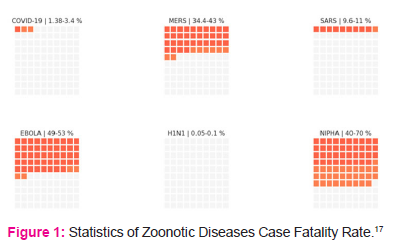
The proportion of individuals who pass away from a defined disease amongst all individuals identified with the condition over a specific time as shown in Fig.117. In this paper, we are working towards the statistical analysis of the Zoonotic diseases and their impact on people's timeline of existence. Diseases like Ebola, SARS, and MERS created a significant loss to humankind over some time.
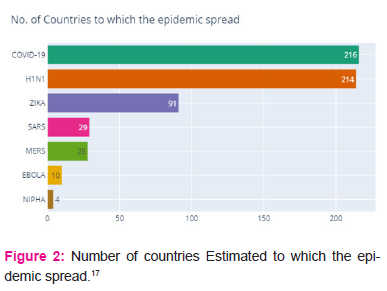
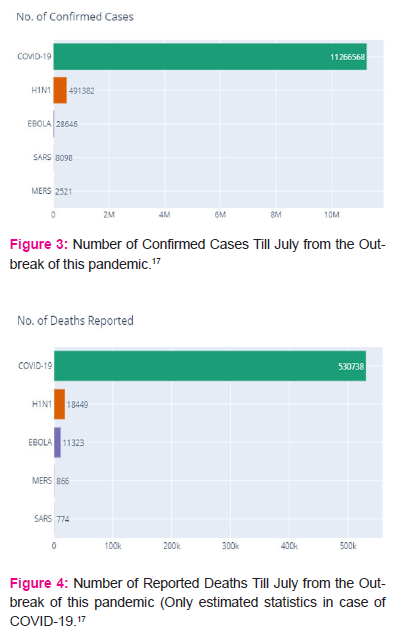
Symptoms
Coming to the clinical symptoms of this life-threatening viral disease, they range from having no symptoms at all (asymptomatic) to very severe respiratory problems, which may eventually lead to people losing their lives. MERS-CoV's most common symptoms reportedly are fever, cough, cold, and a shortage of breath. Pneumonia is also found in most people suffering from this disease but not certainly in every individual affected by it. Gastrointestinal problems like diarrhoea are also some of the symptoms. If the illness becomes too severe, it may lead to various respiratory severe problems. Patients need to be kept on the ventilators and have to be treated in intensive care units to bring the situation back to normal. Although figures say that around 35% of the patients have died fighting this dangerous disease, it should be considered that many of the mild cases of MERS have been excluded in the scrutiny. These rates are counted based on only the information provided by the well-recognized laboratories as shown in Fig 217, Fig317 and Fig417.
Transmission
SARS-CoV-2 is transmitted very efficiently. It is due to two main reasons that it transmits between the persons. When the virus stays in the person their respiratory tract, mouth nose and throat contains the virus and in some when the droplets come out will also have the possibility of holding the virus. When it falls on some others there is a high chance of transmitting the virus that makes very difficult to detect and stop. There may be a chance of not transmitting the virus in a few cases also.so they could also infect other people without knowing that they are infected. So, we need to test symptomatic people and identify whom they have had contact with quickly to limit the spread. This is done through contact tracing. Due to this, the transmission of the virus is likely to occur when the affected person comes closer to another. 1Prisons and jails are examples of congregate housing, as are group homes and dormitories like schools or shelters. These places are all high risk for the rapid spread of the infection because people live close together and share spaces. When we think about the risk of transmission, nursing homes represent a worst-case scenario for COVID-19.
One is a diagnostic test, and that test identifies a virus that's in the body. It is called a PCR test, which stands for a polymerase chain reaction. That is the chemical reaction that's done in the lab to look for the virus. The other one is the antibody test3. Antibodies3are made by your immune system to fight off viruses or bacteria. We can identifyantibodies that are specific to this virus in your blood.
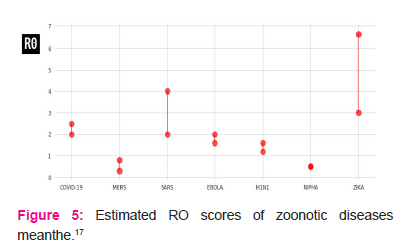
The typical variety of people who will undoubtedly get a transmittable illness from someone keeping that illness as shown in Fig 5.17 It especially applies to a population of people who were previously without infection and have not been vaccinated.
Health-care facilities
The virus is transmitted easily in healthcare environments in several countries, especially from patient to patient and patient to the health care worker and visitors before the MERS-CoV Virus was diagnosed as shown in Table 117. It is highly challenging to diagnose the MERS-CoV Virus without testing, owing to the non-specific nature of clinical features and symptoms that do not show in the disease's early onset. It is critical to prevent the infection and implement control measures to prevent the possible spread of MERS-CoV Virus in health care environments. The facilities that cater to the patients of MERS-CoV Virus need to take adequate measures to avert the risk of transmission of the virus from infected patients to others, including doctors, visitors, and health care workers. Health care workers should be extensively educated and continuously updated about the measures and protocols to prevent and control the virus as shown in Fig 617and Fig 7.17
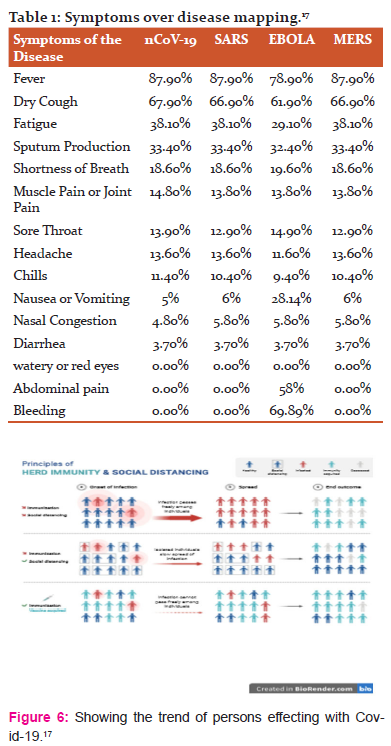

Exploring the nCoV-2019 dataset
The data set, ‘covid_19_data.csv’, contains the following columns:
- Sno Identification Number
- Observation Day Date of the monitoring in MM/DD/YYYY
- Province/State Province or state of the monitoring
- Country/Region Country of observation
- Last Update Time in UTC at which the row updated for the offered district or area
- Confirmed Cumulative variety of confirmed cases up until that day
- Deaths Advancing variety of deaths till that day
- Recouped Cumulative number of recovered instances up until that date
NCoV-19 was epidemiological from 22 January 2020, and the World Health Organization declared a pandemic in March. Presentall the datasets are maintained by the John Hopkins University Center for Systems Science Engineering (JHUCCSE) from the various sources like Ministry of Health Italy, the Republic of China, The Government of Spain, Hong Kong Department of Health Commission, Taiwan ministry of health sciences, Ministry of Health Singapore, European Disease prevention Centre for disease prevention maintain the updated information of every hour and minute. The Republic of China, JSU, and CCSE maintain the entire data process in the GITHUB repository. The Attributes present in the dataset Province/State, Country/Region, Update list, Confirmed, Suspected, Deaths, and Recovered. Hence this data is sufficient for finding out of occurrence or finding out about the severity of the disease. For the Statistical finding, it plays a crucial role.
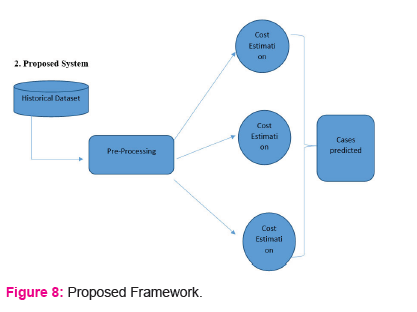
The proposed framework was shown in Fig 8. for predicting the cases.
Literature Review
In a study,1have taken around 142 DNA coding sequences of Middle East respiratory syndrome from the Biotechnology information centre, and also South Korean Quarantined DNA Protein sequences and made a comparative study. They further classified the patterns into several groups. A unique technique for web scraping data from the Twitter handle for the development of a better system for supervision, and they have examined swain flu pandemic and compared the difference between the hypothesis and evidence.2,3In 2016, in an article, Al-Hazmi had made a drastic improvement to find out the symptoms caused by Middle East Respiratory Syndrome (MERS) and Severe Acute Respiratory Syndrome (SARS). He implemented this with the help of various machine learning algorithms. In 2016, Chen established a mathematical induction model to analyze and predict the Ebola virus that originated in Middle Africa. With the help of a Bio Python, they analyzed the sequence of an E protein from various MERS-CoV, causing factors that severely affected humanity.4,5,6 To predict this E protein, MERS he separated the B cells from the sequence using Lase Gene software.In 2019, Kelly et al., statistically proven the accuracy of the SARS by comparing the number of forecasted samples vs. actual outbreak size, by applying the hypothesis testing and out of sample log the likelihood of the person affecting diseases can also be predicted. Machine learning algorithms work fine because of the increase in computational speed.7,8,9 In this paper, he implemented CNN, where he analyzed the result on the epoch's values using Wiener series to predict things and decision making through computational methodologies.10,11,12,13,15
Results
The first thing we can do is generate some statistics on the 'Confirmed' column as shown in Fig.97.
Let us take a look at the mean and standard deviation in confirmed cases:
Mean: 611.8238586156112
Standard Deviation: 5121.319656069395
We can also generate a histogram of confirmed cumulative cases:
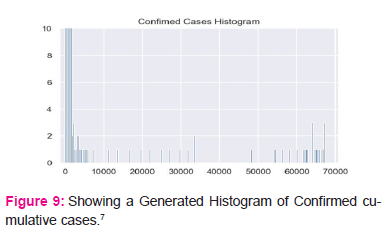
We can generate similar statistics for recovered cases as shown in Fig 10.17
Mean: 167.7042709867452
Standard Deviation: 1650.055340859415

Moreover, finally, we can look at the statistics for deaths as shown in Fig 11.17
Mean: 17.756111929307806
Standard Deviation: 187.19536561001198


We can also use box plots to visualize the distribution in numeric values based on the minimum, maximum, median, first quartile, and third quartile as shown in Fig 12.14
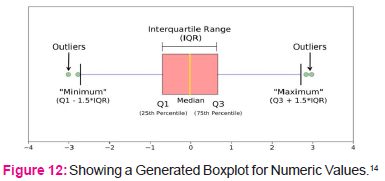
Let us plot the distribution in confirmed cases for 'Anhui,' 'Beijing,' and 'Chongqing' as shown in Fig 13.16

And for deaths as shown in Fig 15.16
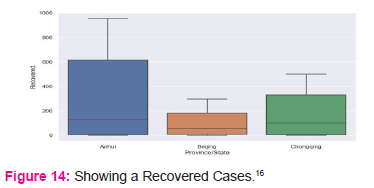
We can do the same for recovered cases as shown in Fig 14.16
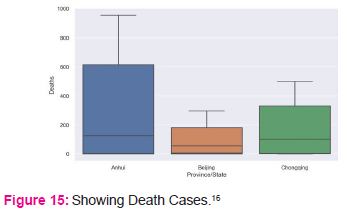

The above fig 16 shows the timeline of Zoonotic viruses effect from2003 to 2019 for table2.16
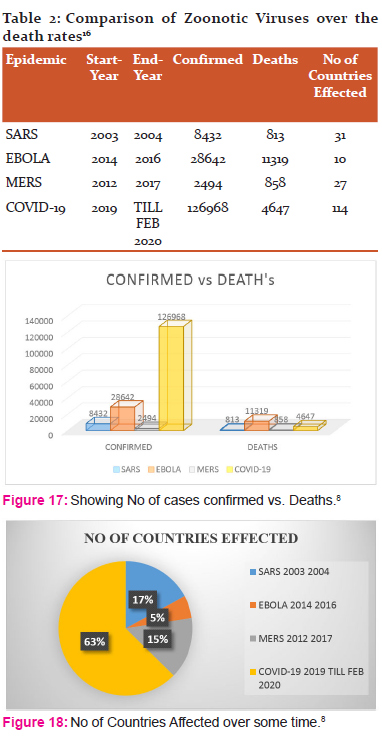

By this, we can estimate the rate of cases confirmed vs. Deaths occurred because of listed viruses in Fig 17.8 and the number of countries affected in Fig 18.8 and Rate of increase of cases in Fig 19.9, which leads to an abnormal increase of effect through the viruses.
Conclusion and future work
Among the family of SARS (Severe Acute Respiratory Syndrome), nCov-19 has dominated all the other Zoonotic Viruses with exponential growth. nCov-19 effected the persons on their protein structure and DNA. By comparing the statistical analysis of confirmed cases vs. deaths within a short period, nCov-19 affected the most compared with Zoonotic viruses. The coronavirus disease remains to spread out throughout the globe, adhering to a trajectory that is challenging to predict. The health, altruistic, and socio-economic policies have taken on by nations will certainly figure out the rate and stamina of the healing. There has to be a global human-centred reaction that is based on solidarity. The unique coronavirus spread out so quickly that it has transformed the rhythm of the globe. Whether from the viewpoint of a single country or multilateral degrees, the solidity of international connections has been put under examination. One of the most noticeable effects includes the economic recession, a situation of global governance, profession protectionism, and also increasing isolationist view. People-to-people, social as well as travel exchanges, have all been restricted. However, this is just the tip of the iceberg.SARS-CoV-2 gets in human cells by binding to ACE2, a cell surface healthy protein that functions as a door to the infected cells. ACE2, an enzyme produced by the ACE2 healthy protein, naturally contributes to the upkeep of high blood pressure but is tricked by the infection into coming to be an entryway. One of the SARS-CoV-2 virus factors is extremely transmittable because it can bind to the ACE2 cell receptor with greater fondness contrasted to the previous SARS-CoV infection, which created the condition called SARG which was much less transmittable, even though it created an epidemic in 2003. All-natural human ACE2 healthy protein variant inscribed in an individual's DNA can enable the infection to bind to ACE2 either strongly or weakly and, therefore, modify their susceptibility to the illness triggered the present pandemic. Further research can be done on Gene mutations that affect the healthy Z-Form of DNA.
ACKNOWLEDGMENTS
Nil.
Conflict of Interest: Nil.
Funding Source: Nil.
References:
-
Ahn I, Jang JH. Comparative study of Middle East respiratory syndrome coronavirus using bioinformatics techniques. In2015 IEEE International Conference on Bioinformatics and Biomedicine (BIBM) 2015 Nov 9 (pp. 1718-1719). IEEE.
-
Jain VK, Kumar S. An effective approach to track levels of influenza-A (H1N1) pandemic in India using twitter. Procedia Computer Science. 2015 Jan 1;70:801-7.
-
Maseleno A, Muslihudin M. Ebola virus disease detection using Dempster-Shafer evidence theory. In2015 IEEE International Conference on Progress in Informatics and Computing (PIC) 2015 Dec 18 (pp. 579-582). IEEE.
-
Al-Hazmi A. Challenges presented by MERS coronavirus, and SARS coronavirus to global health. Saudi journal of biological sciences. 2016 Jul 1;23(4):507-11.
-
Jyothula, H., Rao, S. K., Vallikumari, V. Two-phase active counter mechanism embedded with particle swarm optimization technique for segmentation of biomedical images. Journal of Advanced Research in Dynamical and Control Systems. 2017;9(6):232-42.
-
Kishore Kumar, K., Srinath, A., Harish, M., Vijay, P., Bhaskar, K. Simulation of the four-arm parallel manipulator for medical applications. Journal of Advanced Research in Dynamical and Control Systems. 2017;9(SP-18):1802-09.
-
Kishore Kumar, K., Srinath, A., Sri Naga Venkat, P., Harish, M. Simulation of delta parallel manipulator for medical applications. Journal of Advanced Research in Dynamical and Control Systems. 2017;9(SP-18):1810-17.
-
Rajendra Prasad, C., Bojja, P. A survey on routing protocols in wireless body area networks for medical applications. Journal of Advanced Research in Dynamical and Control Systems. 2018;10(10):92-97.
-
Rajkamal, K., Immadi, G. Optimization of UWB array antenna for biomedical applications using a cuckoo search algorithm. International Journal of Engineering and Technology(UAE). 2018;7(2.20):367-83.
-
Suresh G, Narayana KL, Mallik MK. Bio-Compatible Processing of LENS TM Deposited Co-Cr-W alloy for Medical Applications. International Journal of Engineering & Technology. 2018;7(2.20):362-6.
-
Vamsidhar, E., Saichandana, B., Harikiran, J. A novel approach for feature selection and classifier optimization compressed medical retrieval using a hybrid cuckoo search. Indonesian Journal of Electrical Engineering and Informatics. 2018;6(4):410-17.
-
Aparna P, Kishore PV. An efficient medical image watermarking technique in E-healthcare application using hybridization of compression and cryptography algorithm. Journal of Intelligent Systems. 2018 Jan 26;27(1):115-33.
-
Gera, P., Sabbisetty, V. B., Devarasetty, T., Nukala, M., & Vittamsetty, N. A fuzzy preference tree-based recommender system for a medical database. International Journal of Engineering and Technology(UAE). 2018; 7(1.1):319-21.
-
Sastry KJ, Ketaraju VD. A Document Ranking Approach based on Weighted-Gene/Protein in Large Biomedical Documents using MapReduce Framework. International Journal of Simulation--Systems, Science & Technology. 2018 Dec 1;19(6).
-
Pilla Srinivas, Debnath Bhattacharyya, Divya Midhun Chakkaravarthy. An Artificial Intelligent based System for Efficient Swine Flu Prediction using Naive Bayesian Classifier International Journal of Current Research and Review. 2020 Aug;12(15):134-139
-
Jaiswal A, Gianchandani N, Singh D, Kumar V, Kaur M. Classification of the COVID-19 infected patients using DenseNet201 based deep transfer learning. Journal of Biomolecular Structure and Dynamics. 2020 Jul 2:1-8.
-
Tuli S, Tuli S, Tuli R, Gill SS. Predicting the Growth and Trend of COVID-19 Pandemic using Machine Learning and Cloud Computing. Internet of Things. 2020 May 12:100222.
|






 This work is licensed under a Creative Commons Attribution-NonCommercial 4.0 International License
This work is licensed under a Creative Commons Attribution-NonCommercial 4.0 International License